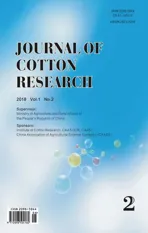A genome-wide analysis of SWEET gene family in cotton and their expressions under different stresses
2018-11-10ZHAOLanjieYAOJinboCHENWeiLIYanYoujunGUOYanWANGJunyiYUANLiLIUZiyangandZHANGYongshan
ZHAO Lanjie,YAO Jinbo,CHEN Wei,LI Yan,LÜ Youjun,GUO Yan,WANG Junyi,YUAN Li,LIU Ziyang and ZHANG Yongshan*
Abstract Background:The SWEET(Sugars will eventually be exported transporters)gene family plays multiple roles in plant physiological activities and development process.It participates in reproductive development and in the process of sugar transport and absorption,plant senescence and stress responses and plant-pathogen interaction.However,thecomprehensive analysis of SWEET genes has not been reported in cotton.Results:In this study,we identified 22,31,55 and 60 SWEET genes from the sequenced genomes of Gossypium arboreum,G.raimondii,G.hirsutum and G.barbadense,respectively.Phylogenetic tree analysis showed that the SWEET genes could be divided into four groups,which were further classified into 14 sub-clades.Further analysis of chromosomal location,synteny analysis and gene duplication suggested that the orthologs showed a good collinearity and segmental duplication events played a crucial role in the expansion of the family in cotton.Specific MtN3_slv domains were highly conserved between Arabidopsis and cotton by exon-intron organization and motif analysis.In addition,the expression pattern in different tissues indicated that the duplicated genes in cotton might have acquired new functions as a result of sub-functionalization or neo-functionalization.The expression pattern of SWEET genes showed that the different genes were induced by diverse stresses.The identification and functional analysis of SWEET genes in cotton may provide more candidate genes for genetic modification.Conclusion:SWEET genes were classified into four clades in cotton.The expression patterns suggested that the duplicated genes might have experienced a functional divergence.This work provides insights into the evolution of SWEET genes and more candidates for specific genetic modification,which will be useful in future research.
Keywords:Gossypium,Sugars will eventually be exported transporters(SWEETs),Gene expression patterns,Stress
Background
Sugar is a major carbon source and energy source for higher plants in their growth and development(Walmsley et al.1998;Lalonde et al.2004;Chen et al.2010;Chen et al.2012).Higher plants can use convert CO2into organic carbon in photosynthetic leaves(the source).The source is involved in the storage and transport of nutrients in plants(Ruan 2014;Rolland et al.2002).However,sugar cannot be transported independently across the plant cell membrane system and requires the assistance of appropriate sugar transporters,such as MSTs(monosaccharide transporters)(Slewinski 2011),SUTs(sucrose transporters)(Kuhn and Grof 2010;Ayre 2011)and SWEETs(sugars will eventually be exported transporters)(Chen et al.2010).
SWEETs are a new family of sugar transporters discovered in recent years,generally with seven transmembrane domains and two MtN3 motifs(Talbot 2010;Baker et al.2012).SWEET shows the function of bidirectional reversible transport of sugar,and promotes the diffusion of sucrose to the apoplast pathway through transmembrane across the gradient of concentration on cell efflux(Baker et al.2012;Lin et al.2014;Eom et al.2015).Since SWEET was first discovered using Forster resonance energy transfer(FRET)by optical glucose sensors(Chen et al.2010),SWEET family members have been identified by genome-wide analyses in different plant species,such as Arabidopsis(Chen et al.2010),rice(Yuan and Wang 2013),tomato(Feng et al.2015),soybean(Patil et al.2015)and cucumber(Hu et al.2017).
At present,researches on the functions of SWEET genes are carried out mainly in Arabidopsis and rice,while only a small part of them have been functionally characterized.The functions of transporting glucose and sucrose are identified in most well-studied SWEETs currently(Chen et al.2010;Chen et al.2012).For example,AtSWEET1 is involved in the regulation of glucose uptake and efflux(Chen et al.2010;Sonnewald 2011).OsSWEET11 and OsSWEET14 are the low affinity transport sucrose carriers that may be involved in the phloem sucrose loading process(Chen et al.2012;Chen 2014).AtSWEET1/4/5 may directly involve in the transport of sugar to regulate the osmotic active substances,or participate in cell wall sugar loading(Bauer et al.2013).Other SWEETs have the function of transporting fructose and galactose(Klemens et al.2013;Guo et al.2014;Zhou et al.2014).AtSWEET16 and AtSWEET17 are highly expressed in roots and involved in the transportofmonosaccharidesand polysaccharides across tonoplast(Klemens et al.2013;Guo et al.2014;Chardon et al.2013).In addition,SWEETs participate in the transport of sugar and ions.AtSWEET13 is involved in the regulation of aluminum ion balance in plants(Zhao et al.2009).OsSWEET11 forms a complex with two othercoppertransporterprotein COPT1 and COPT5 in the plasma membrane(Yuan et al.2009;Yuan et al.2010),regulating the transport of copper ions and sugars(Yuan et al.2010).
It has been found that some SWEETs take part in plant reproductive development also.AtSWEET9 transports sucrose into apoplasts for nectar secretion(Lin et al.2014).AtSWEET8,a glucose transporter expressed in tapetum and embryo sacs,participates in the development of the pollen and anther(Guan et al.2008;Sun et al.2013).The silenced AtSWEET11 mutant showed lower pollen viability and even pollen sterility(Sonnewald 2011).Suppression of OsSWEET11 resulted in pollen dysplasia,leading to male infertility(Yuan et al.2009;Liu et al.2011;Ge et al.2000).AtSWEET5 was highly expressed in the female gametophyte during the three-cell pollen stage(Yuan etal.2010).Someresearcheshaveshowed that SWEETs plays a role in the process of plant senescence and response to abiotic stresses.AtSWEET15 can be induced by cold,salt and drought stress(Seo et al.2011).Overexpressing AtSWEET16 improved the tolerance to cold stress,osmotic stress and nitrogen availability in Arabidopsis(Klemens et al.2013).In addition,SWEETs from other plants(e.g.,Hordeum vulgare,tomato,etc.)are also involved in the regulation of abiotic stress(Yuan and Wang 2013).
Although some studies have been reported in cotton,such as,SWEETs are involved in sugar transport during fiber elongation and bacterial blight of cotton(Zhang et al.2017;Cox et al.2017;Phillips et al.2017),the function of SWEET in cotton,especially in stress response and host-pathogen interaction,has not been identified until now.With the release of genomes sequences of two diploid cotton(A2,D5)and two allotetraploid cotton(AD1,AD2)(Phillips et al.2017;Li et al.2014;Paterson et al.2012;Wang et al.2012;Li et al.2015;Zhang et al.2015;Yuan et al.2015;Liu et al.2015)facilitates the survey of SWEETs in cotton.In this study,we identified the SWEETs in four cotton species by genome-wide analysis.This results will provide insights into the evolution of SWEET genes and more candidates for specific genetic modification,which will be useful in future research.
Results
Gene identification and conserved domain retrieval
The SWEETamino acid sequences reported in Arabidopsis,rice and cucumber were used as query sequences and blasted against sorghum,poplar,maize,cocoa,Gossypium arboreum,G.raimondii,G.hirsutum,and G.barbadense genome database with e-values of 1e-5.Twenty-three candidates in sorghum,27 in poplar,24 in maize,21 in cacao,31 in G.arboreum,32 in G.raimondii,60 in G.hirsutum,and 60 in G.barbadense were obtained,respectively,then,the conserved domain(IPR004316)was analyzed in the candidate SWEET gene family members by the PROSITE(http://prosite.expasy.org/)and InterProscan (http://www.ebi.ac.uk/interpro/)(Jones et al.2014).Eventually,23,27,22,21,22,31,55,and 60 genes were identified as SWEET family members,respectively(Table 1,Additional file 1:Table S1,Additional file 2:Table S2,and Additional file 3:Table S3).The high similarity of SWEET genes was found from two upland cotton genomes Nangjing Agri.Univ.version 1.1(NAU version 1.1)and Beijing Genome Institute&Institute of Cotton Research of CAAS version 1.0(BJI version 1.0)),and the genes from NAU,version 1.1 contained all the members from BJI version 1.0.Therefore,the SWEET genes from the NAU(Additional file 2:Table S2)were analyzed as samples from G.hirsutum.Since all SWEETs of G.barbadense on COTTONGEN came from scaffolds,we chose SWEET genes from G.barbadense on cottonFGD for analyses(Additional file 3:Table S3).The total numbers of SWEET genes identified in the two diploid cotton(G.arboreum and G.raimondii)were lower than that in allotetraploid(G.hirsutum and G.barbadense)cotton(Table 1,Additional file 1:Table S1,Additional file 2:Table S2 and Additional file 3:Table S3).
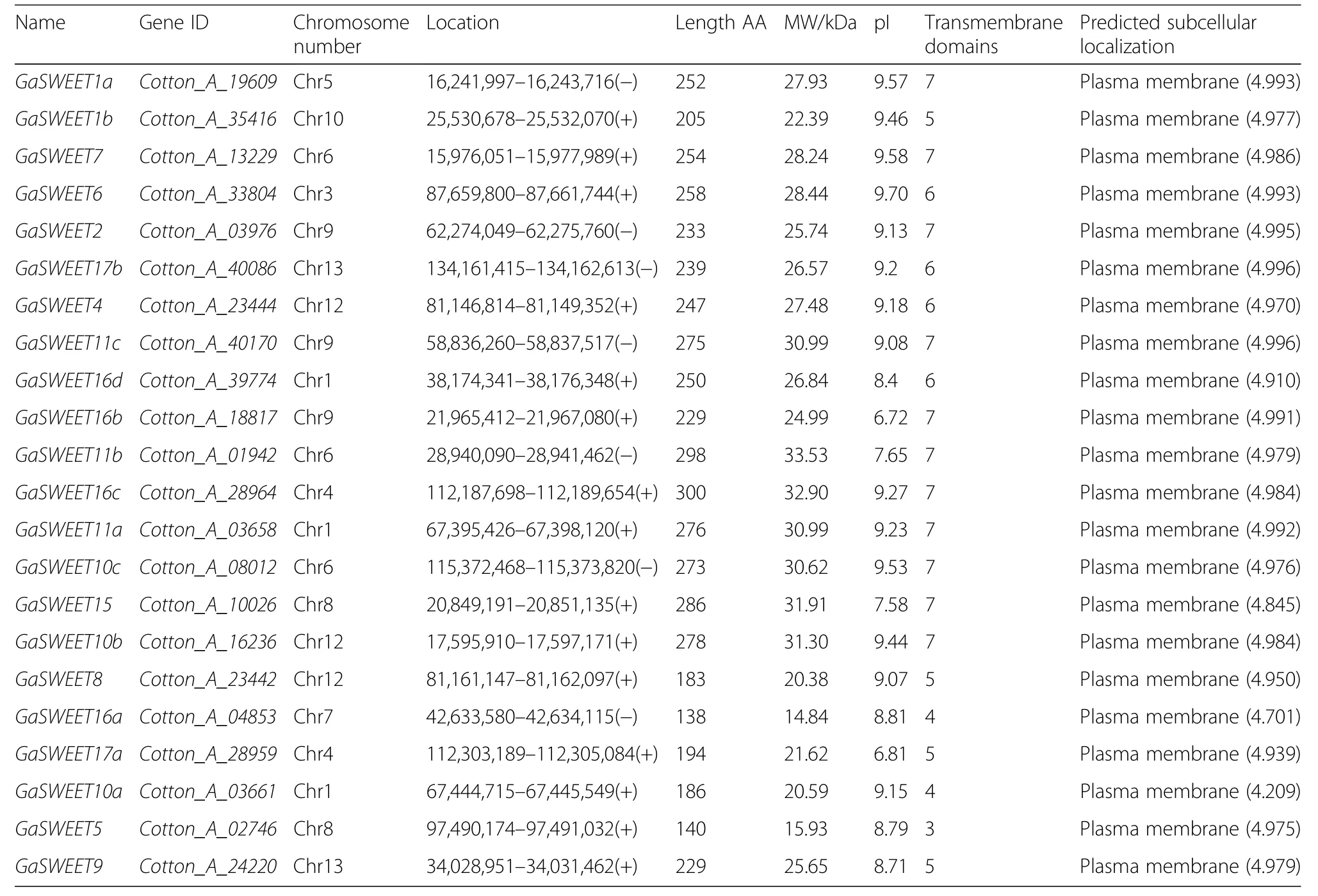
Table 1 SWEET gene family in G.arboreum
These 168 SWEET genes of four cotton species were named according to their homologous genes in Arabidopsis.Each AtSWEETgene corresponded to approximately one to ten cotton SWEET genes,respectively.The naming rules were performed based on a published paper(Yang et al.2017).Ga,Gr,Gh,Gb,and At were used as prefixes before the names of SWEET genes from G.arboreum,G.raimondii,G.hirsutum,G.barbadense,and Arabidopsis,respectively.“a”,“b”,“c”,“d”,“e”,and “f”were appended to the gene names to distinguish the homologous genes(Table 1,Additional file 1:Table S1,Additional file 2:Table S2,and Additional file 3:Table S3).More than 88.69%of the 168 identified SWEET genes encode proteins ranging between 180 to 311 amino acids(AA),except for 19 genes with different lengths,i.e.,less than 180 or more than 311 AA(Table 1,Additional file 1:Table S1,Additional file 2:Table S2,and Additional file 3:Table S3).The molecular weights(kDa)and isoelectric points(pI)of these predicted SWEET proteins ranged from 9.93 to 38.04 kDa,and from 5.47 to 10.08,respectively(Table 1,Additional file 1:Table S1,Additional file 2:Table S2,and Additional file 3:Table S3).Moreover,the protein subcellular localization prediction showed that the 168 SWEET proteins were located in the plasma membrane(Table 1,Additional file 1:Table S1,Additional file 2:Table S2,and Additional file 3:Table S3).The transmembrane domains(TMs)of 168 SWEET proteins were predicted by using the TMHMM Server v.2.0.The results showed that 101 SWEET proteins had 7 TMs.GrSWEET6a,GrSWEET10c and GhSWEET10c_Dt had 8 TMs.Fifty-eight SWEET proteinshad46TMs.GaSWEET5,GhSWEET3a_Dt,GhSWEET3b_At,GbSWEET2c_A,and GbSWEET3b_D had 3 TMs.GbSWEET11_A had 2 TMs(Table 1,Additional file 1:Table S1,Additional file 2:Table S2,and Additional file 3:Table S3).The different numbers of transmembrane domains contained in these SWEET proteins indicated different functions.
Phylogenetic relationship analysis of SWEETs
To understand the evolutionary history of SWEET proteins among Gossypium and other species,phylogenetic analysis of 314 SWEET protein sequences(168 from cotton,22 from maize,19 from rice,23 from sorghum,27 from Populus trichocarpa,21 from cocoa,17 from Arabidopsis thaliala,and 17 from cucumber)was performed by their sequence similarities with orthologs,using the neighbour-joining(NJ)method in MEGA 7.The result showed that SWEET proteins could be classified into four clades,namely,the I clade,II clade,III clade,and IV clade(Fig.1).III clade,the largest one,contained 111 SWEET members,while I,II and IV clade contained 70,71 and 62 members,respectively.To validate the phylogenetic tree constructed byNJ method,we also used the minimum evolution method to construct a tree.The results showed that SWEET proteins also were divided into four clades,almost consistent with the NJ method(Additional file 4:Figure S1).Although,there were differences between the topologies of the two trees constructed by the two methods,the members within the sub-clades and the topology within the sub-clades were relative stable,which indicated that the NJ tree could be used for further analysis.
To further study the evolutionary relationship and to predict the gene function,the SWEETs were divided into 14 sub-clades,named as α-ξ,respectively(Fig.1).I clade included three sub-clades,II clade included three sub-clades,III clade included five sub-clades,and IV clade included three sub-clades.Interestingly,α,β,γ,δ,ε,ζ,μ,and ξ sub-clades were constituted of SWEETs from the monocotyledon species and dicotyledon species.The η, θ, ι, κ,and ν sub-clades were composed of SWEETs from dicotyledon species and the λ sub-clades were composed of SWEETs from the monocotyledon species.δ sub-clade contained the fewest members.
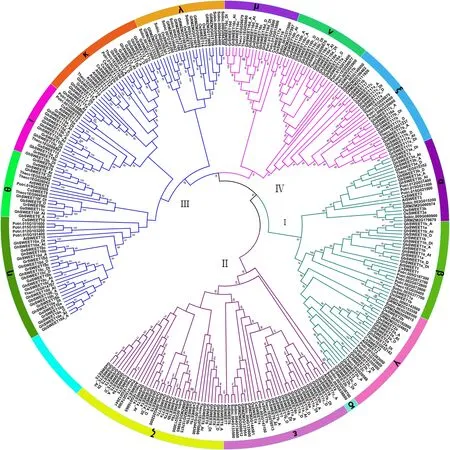
Fig.1 Phylogenetic relationship of SWEETs from cotton,Arabidopsis,rice,cacao,poplar,sorghum,cucumber and maize.The phylogenetic tree was generated using MEGA 6.0 with the NJ method with 1 000 bootstrap replicates.MEGA 7.0 was used for constructing the NJ tree.The I clade,II clade,III clade,and IV clade is marked in cyan,purple,blue and pink,respectively.Each clade was classified into sub-clades,marked in different colors on the circle.α to γ represent the sub-clades in the I clade,δ and ζ represent the sub-clades in the II clade,η to λ represent the sub-clades in the III clade,and μ to ξ represents the IV clade.The prefixes Ga,Gr,Gh,Potri,At,Os,GRMZM,Sobic,and Thecc stand for G.arboreum,G.raimondii,G.hirsutum,Populus trichocarpa,Arabidopsis thaliala,Oryza sativa,Zea mays,Sorghum bicolor,and Theobroma cacao,respectively.The appendices At and Dt in the upland cotton indicate the A-and D-subgenome,respectively.The bootstrap values are shown near the nodes,and only those values greater than 50 are displayed
Among the various sub-clades of the phylogenetic tree,SWEETs from cotton were more closely related to those in cacao because they always clustered closely together with each other,except for the δ sub-clade and the λ sub-clade.In most cases,one cocoa gene corresponded to two or more than two homologous SWEET members from different cotton species.Among them,the two largest number of cotton homologous SWEET protein from different cotton species corresponding to one cacao protein in the β sub-clade and ε sub-clade were 12 SWEETs and 18 SWEETs,respectively(Fig.1).There was the least cotton homologous SWEET members corresponding to one cacao gene in γ sub-clade,only had two genes(GrSWEET2c and GbSEET2b_A).These cotton SWEETs in almost all sub-clades showed that a tendency to cluster into the same sub-clade due to their relatively conserved functions.Almost all cotton orthologs from the A genome and At subgenome or from the D genome and Dt sub-genome tended to form an orthologous pairs at the ends of the clades,suggesting there was a closer relationship between the orthologs from At-A or Dt-D in cotton.
Genomic localization and duplication of SWEET genes in cotton
The identified 168 SWEETs from 4 cotton species were mapped to the corresponding chromosomes or scaffolds,indicating an uneven distribution(Fig.2).158 of 168 SWEETswerelocatedtochromosomes,whilethe remaining 10 SWEETs from two allotetraploid cotton(G.hirsutum and G.barbadense)located in unmapped scaffolds.The identified 22 SWEET genes were assigned to 11 chromosomes from G.arboreum except A2_chr02 and A2_chr11(Fig.2a).Chromosomes A2_chr01,A2_chr06,A2_chr09,and A2_chr12 contained the most of SWEET genes,with 3 per chromosome.Chromosomes A2_chr03,A2_chr05,A2_chr07,and A2_chr10 contained 1 gene per chromosome,Other chromosomes contained 2 genes.Thirty-one SWEET genes were distributed on the 11 chromosomes in G.raimondii,no gene was found on chromosomes D5_chr06 and D5_chr10(Fig.2b).Chromosome D5_chr13 contained 5 genes.Chromosomes D5_chr02 and D5_chr09 had only 1 gene,and other chromosomes had 24 genes.
Forty-nine SWEETs were located in 23 chromosomes from G.hirsutum,while no gene was found on chromosome AD1_A06,AD1_D06,or AD1_D09(Fig.2c).Chromosomes AD1_A07,AD1_A11,AD1_D11,and AD1_D13 contained 4 SWEETs per chromosome,whereas chromosomes AD1_A01,AD1_A03,AD1_A04,AD1_A08,AD1_A09,AD1_A10,AD1_D01,AD1_D05,and AD1_D08 contained one gene per chromosome.In addition,other chromosomes contained 23 SWEET genes.Except for A01-D01,A08-D08,A11-D11,and A12-D12,the number of genes located on the chromosome in At subgenome was the same as that on the homologous chromosome in Dt subgenome,which implied that some genes were lost during the evolution or sequencing fault.In addition,GhSWEET7a_At was located on AD1_A02,GhSWEET7a_Dt was not found on chromosome AD1_D02,while it was located on AD1_D03.Similarly,GhSWEET4_At and GhSWEET8_At were located on AD1_A05,while they were not found on the corresponding AD1_D05,but on chromosome AD1_D03.Therefore,our results supported the hypothesis that a chromosome translocation occurred between AD1_A02 and AD1_D02,and also occured between AD1_A03 and AD1_D03 during the allotetraploidization.
Fifty-six SWEETgenes were mapped on 22 chromosomes in G.barbadense,while no gene was found on chromosomes AD2_A06,AD2_D01,AD2_D05,or AD2_D06(Fig.2d).Chromosome AD2_D12 contained 5 genes,Chromosomes AD2_A03,AD2_A04,AD2_A09,AD2_D04,and AD2_D09 contained only 1 gene,respectively.Other chromosomes had 24 genes.As with upland cotton,except for A04-D04,A07-D07,A08-D08,A09-D09,and A10-D10,the number of genes located on the chromosome in At subgenome was the same as that of its homologous chromosome in Dt sub-genome,implied that some SWEET genes might have been lost during the evolution.In addition,chromosome translocation occurred between AD2_A02 and AD2_D03 in G.barbadense.For example,GbSWEET1a-A and GbSWEET7d-A were located in AD2_A02,while no gene was found on AD2_D02,and GbSWEET1a-D and GbSWEET7d-D distributed in AD2_D03.
To date,the mechanism of SWEET gene family expansion in cotton species remained unclear.Therefore,we studied the relationship between genetic differentiation and gene duplication within the SWEET gene family of four cotton species.A total of 51 pairs of SWEET genes were involved in segmental duplication events(defined as a method)by screening alignments of 158 genes on different chromosomes,while the tandem duplication event was not found(Fig.3,Additional file 5:Table S4).The result showed that segmental duplication happened during the evolution and expansion of SWEETs in cotton.Nineteen pairs of genes with segmental duplication events were found in G.hirsutum,while 24 pairs in G.barbadense,3 pairs in G.arboreum and 5 pairs in G.raimondii.
Analysis of gene structure and MtN3_slv domain location
To further investigate the diversification and evolution of the SWEET gene structure and conserved domain in cotton,we constructed the phylogenetic tree using MtN3_slv domain amino acid sequences from four cotton species and the A.thaliala,respectively(Fig.4,Additional file 6:Figure S2,Additional file 7:Figure S3,and Additional file 8:Figure S4),the result showed that the genes were classified into 4 clades as above.23,25,10,7 paralogous pairs of SWEET genes from G.hirsutum,G.barbadense,G.raimondii and G.arboreum in cotton were identified at the terminal nodes of the phylogenetic tree in contrast to 4 pairs in A.thaliala(Fig.4a,Additional file 6:Figure S2a,Additional file 7:Figure S3a,and Additional file 8:Figure S4a).
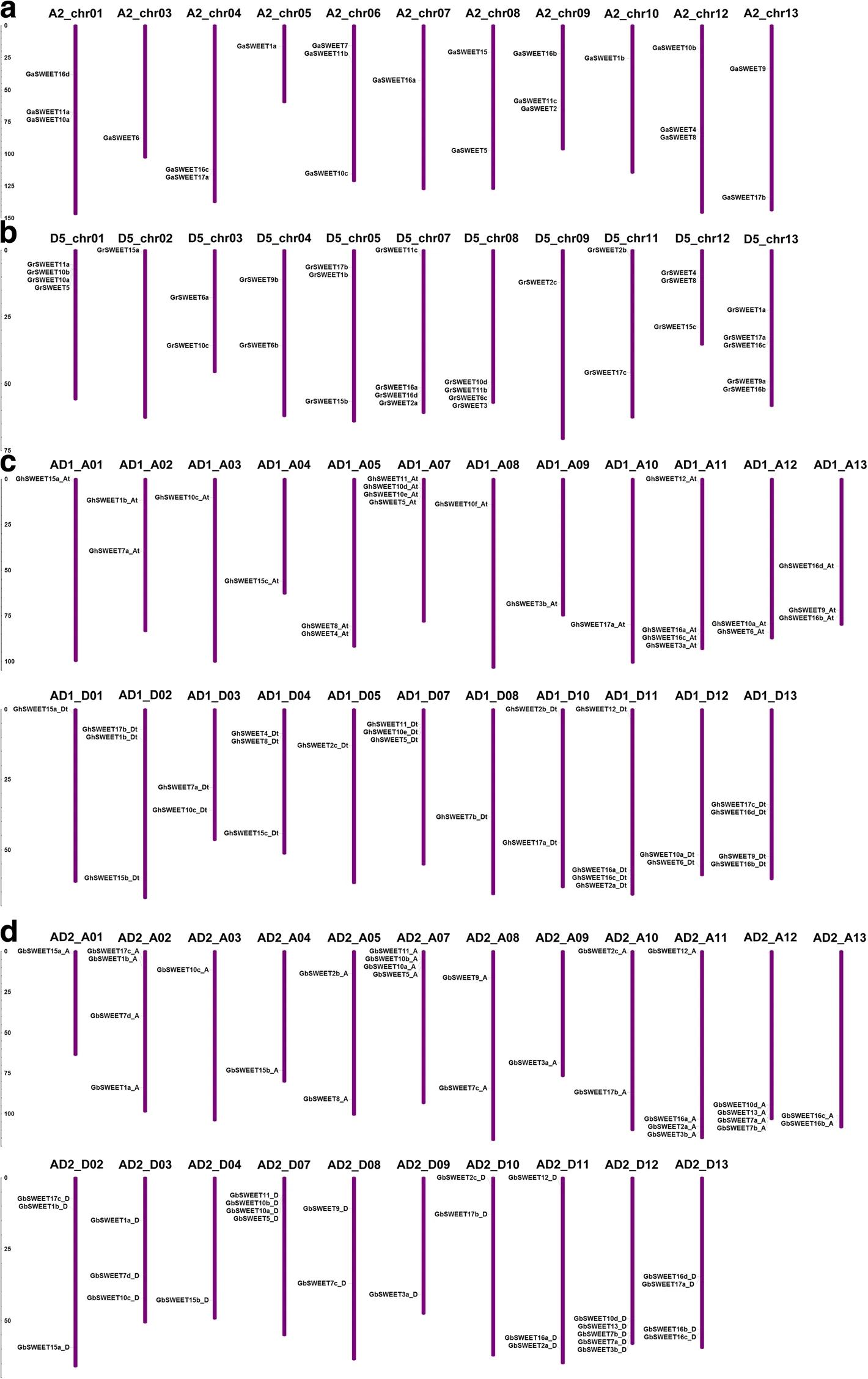
Fig.2 The location of SWEET genes from four species cotton on Chromosomes.The scale represents megabases(Mb).The chromosome numbers of G.arboreum(A2_chr01-A2_chr13)(a),G.raimondii(D5_chr01-D5_chr13)(b),G.hirsutum(AD1_A01-AD1_A13,AD1_D01-AD1_D13)(c),and G.barbadense(AD2_A01-AD2_A13,AD2_D01-AD2_D13)(d)are indicated above each vertical bar.The purple vertical bar indicated the chromosome
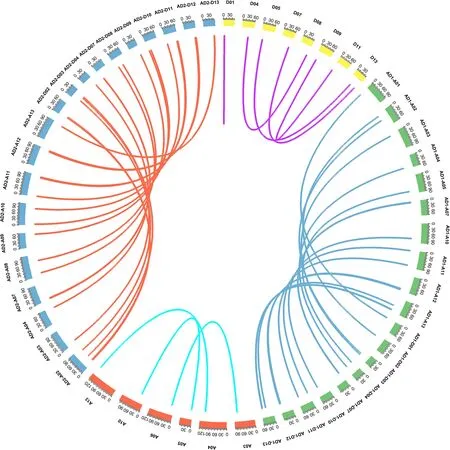
Fig.3 The Circos diagram of paralogous gene pairs identified in GaSWEETs,GrSWEETs,GhSWEETs and GbSWEETs.The chromosomes of G.arboreum,G.raimondii,G.hirsutum,and G.barbadense were filled with red,orange,cyan and blue colors,respectively.A line between two genes indicates a paralog
Based on the evolutionary relationship of phylogenetic tree,the detailed features of exon/intron and conserved domains of the SWEET genes were shown in Fig.4a(Additional file 6:Figure S2a,Additional file 7:Figure S3a and Additional file 8:Figure S4a).Most AtSWEETs contained 6 exons and 5 introns,except for AtSWEET6(1 exon and no intron)and AtSWEET7(5 exons and 4 introns),In cotton,most SWEET genes contained 37 exonsand 2–6 introns,exceptfor GbSWEET10a-Aand GbSWEET10a-D(9 exons and 8 introns,respectively)from G.barbadense.The SWEET genes within the same sub-clade exhibited similar exon/intron structures,especially in paralogous gene pairs,most of them shared a conserved exon/intron structure in terms of gene length or number of introns.Some variations of the exon/intron structure were foundbetweenGaSWEET1a/1b,GaSWEET16a/16b,GaSWEET17a/17b,indicating that loss of introns or gain events during evolution.The results indicated that the exon/intron structures were highly conserved in each sub-clade,and identicalto the phylogenetic relationships.
The proteins of SWEET family were characterized by MtN3/saliva(MtN3_slv)conserved domain in previous studies(Talbot 2010;Baker et al.2012).The typical conserved domains in the 168 SWEET proteins were identified in this study(Fig.4c,Additional file 6:Figure S2C,Additional file 7:Figure S3C,and Additional file 8:Figure S4C).The result revealed that MtN3_slv were considerably conserved,with domain ranged from 117 to 279 aa.Most members of SWEET protein family contained two MtN3_slv domains,while 20 SWEET proteins only contained one,GhSWEET10a_At contained three MtN3_slv domains,(Fig.4c,Additional file 6:Figure S2C,Additional file 7:Figure S3C,and Additional file 8:Figure S4C).The difference of the number of conserved domains in different SWEET protein suggested the diversity of their functions in cotton.
Expression patterns of SWEET genes in different tissues
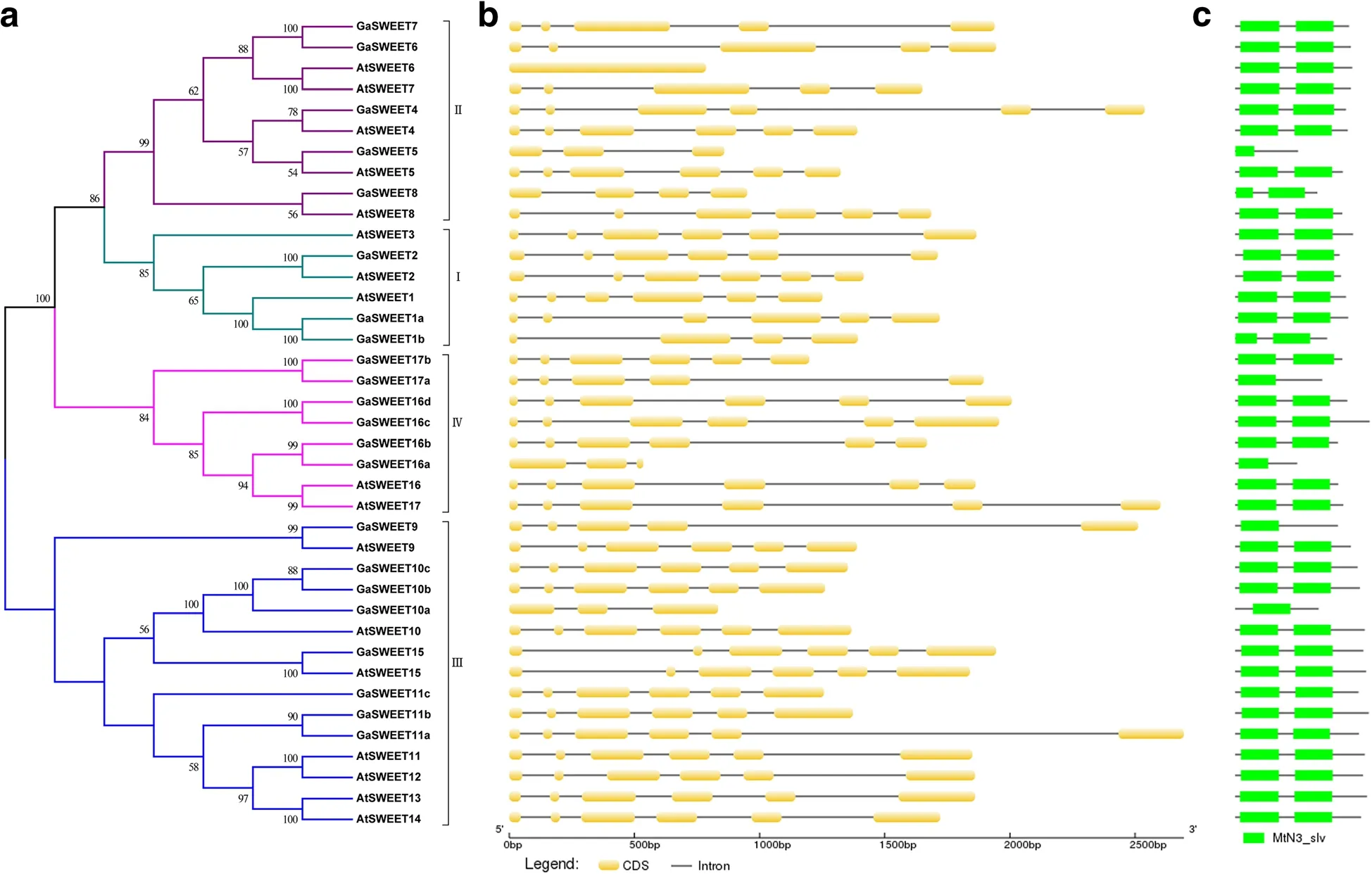
Fig.4 Phylogenetic relationships,gene structure and domains compositions of GaSWEETs.a Phylogenetic relationship of SWEET proteins from A.thaliana and G.arboreum.The phylogenetic tree was constructed using MEGA 6.0 with the NJ method with 1 000 bootstrap replicates.The I clade,II clade,III clade,and IV clade is marked in cyan,purple,blue and pink,respectively.b Exon/intron structures of GaSWEETs.The introns and CDS are represented by orange boxes and black lines,respectively.c Protein domains.Each domain is represented in the colored box
We investigated the temporal and spatial transcription patterns and putative functions of different SWEET genes during growth and development of G.hirsutum plant.The transcription levels in various tissues or organs of RNA-seq data from NCBI and COTTONFGD(http://www.cottonfgd.org/)were downloaded and analyzed(Yuan et al.2015;Yang et al.2017),including the vegetative(root,stem,and leaf)and reproductive(torus,petal,stamen,pistil,calycle,-3 and-1 days post anthesis(DPA)ovule,0,1,3,5,10,20,25,and 35 days post anthesis(DPA)seed)tissues as well as in the fiber(5,10,20,and 25 DPA),and germinating seeds at 0 h,5 h,10 h and from roots and cotyledons at 24 h,48 h,72 h,96 h,and 120 h after imbibition.Their expression levels were varied(Figs.5 and 6)indicating that SWEETs play different biological functions in different tissues of G.hirsutum.
GhSWEET5_At/Dt,GhSWEET6_At,GhSWEET8_At,and GhSWEET10f_At were not detected in roots,stems or leaves,SWEET2a_At/Dt expressed both in vegetative and reproductive tissues.SWEET6a_At/Dt expressed in reproductive tissues.Some SWEETs showed higher expression levels in reproductive tissues especially in floral organs,such as SWEET1a_At/Dt(petals,sepals,and 10–25 DPA fibers),SWEET1b_At/Dt(stamen,-1 DPA ovule,1DPA and 5DPA seeds,10 DPA fiber),SWEET2a_At/Dt(petals and stamens),SWEET7a_At/Dt(petals and stamens).The results indicated that SWEETs also involved in the reproductive development of cotton,consistent with the results in Arabidopsis and rice(Yuan et al.2009;Yuan et al.2010;Guan et al.2008;Sun et al.2013;Liu et al.2011;Ge et al.2000).In addition,SWEET2a_At/Dt,SWEET1b_Dt and SWEET4_At were detected with high expression levels in germinating seed,cotyledons and roots during germination (Fig.6).SWEET1b_At expressed in germinating seeds and from cotyledons after imbibitions.SWEET10a_Dt,GhSWEET10e_At,GhSWEET10d_At and GhSWEET10b expressed in cotyledons and roots after imbibition.GhSWEET17a_At/Dt,GhSWEET17c_Dt,GhSWEET17b_Dt and GhSWEET3a_At/Dt expressed in roots after imbibition.These SWEETs may be involved in the metabolic transport of sucrose during the germination of cotton seeds.
The expression patterns of orthologous genes between At and Dt in different tissues and organs were not always identical;for example,GhSWEET10e_At expressed in roots,receptacles,and carpels,while the expression of GhSWEET10e_Dt was not detected.GhSWEET4_At expressed in both germinated seeds and hypocotyls and roots,butthe expression ofGhSWEET4_Dtwas undetectable.
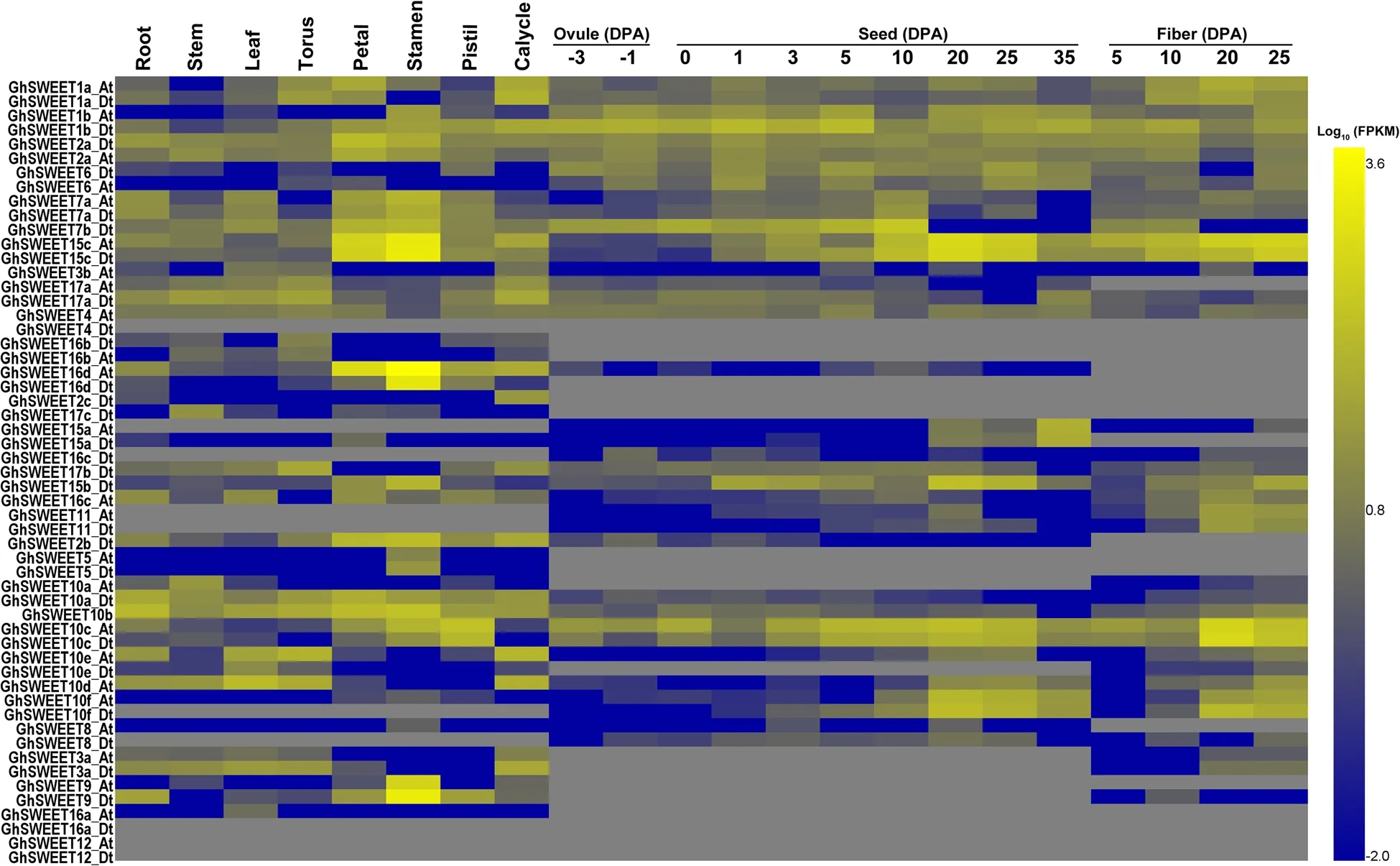
Fig.5 Expression patterns of SWEETs in different tissues of G.hirsutum
Expression patterns of SWEET genes under multiple stresses
Cotton is frequently threatened by multiple abiotic stresses during growth and development.Therefore,we conducted a comprehensive analysis of SWEETs expression patterns under the conditions of cold,heat,PEG 6000 and NaCl multiple abiotic stresses from the RNA-seq data(Fig.7).
Most SWEET genes were found to be down-regulated under salt and PEG 6000 conditions.GhSWEET1a_At/Dt,GhSWEET1b_At/Dt and so on showed a relatively stable expression response to multiple stress treatments.GhSWEET2a_At/Dt,GhSWEET3a_Dtandespecially GhSWEET2b_Dt were strongly induced by cold stress,showing up-regulated expression.GhSWEET4_At and GhSWEET10e_Dt showed up-regulated expression under hot treatment.In addition,based on the RNA-seq data,we selected 9 genes(contains a pair of homologous genes)highly expressed under PEG 6000 or NaCl treatment and designed specific primers(Fig.7;Additional file 9:Table S5)for qRT-PCR detection of leaves from plants treated with PEG 6000 or NaCl(Fig.7).The expression pattern of SWEET genes detected by qRT-PCR was found to be coincided with the results of RNA-seq data(Fig.8).These results indicated that they might take part in response to stress.
Discussion
SWEET gene family in cotto n underwent enlargement during the evolution
SWEET genes family in A.thaliala(Chen et al.2010),rice(Chen et al.2012),tomato(Feng et al.2015),Soybean(Patil et al.2015)and cucumber(Hu et al.2017)have been systematically analyzed.In this study,we performed a comprehensive investigation and analysis of SWEET genes from four cotton species,22,31,55 and 60 SWEET genes were identified from G.arboreum,G.raimondii,G.hirsutum,and G.barbadense,respectively.Cotton contained more SWEET genes than species mentioned above,indicating that SWEET familygenesundergoextensiveexpansion during cotton evolution.Although polyploidization was the main contributor in duplication,segment repeats also play an irreplaceable role in the expansion of gene families in the genome(Paterson et al.2012;Li et al.2015).Fifty-one segment repeat pairs in 4 cotton species were found in our study,suggesting that segment duplication further promote the expansion of the SWEET family.
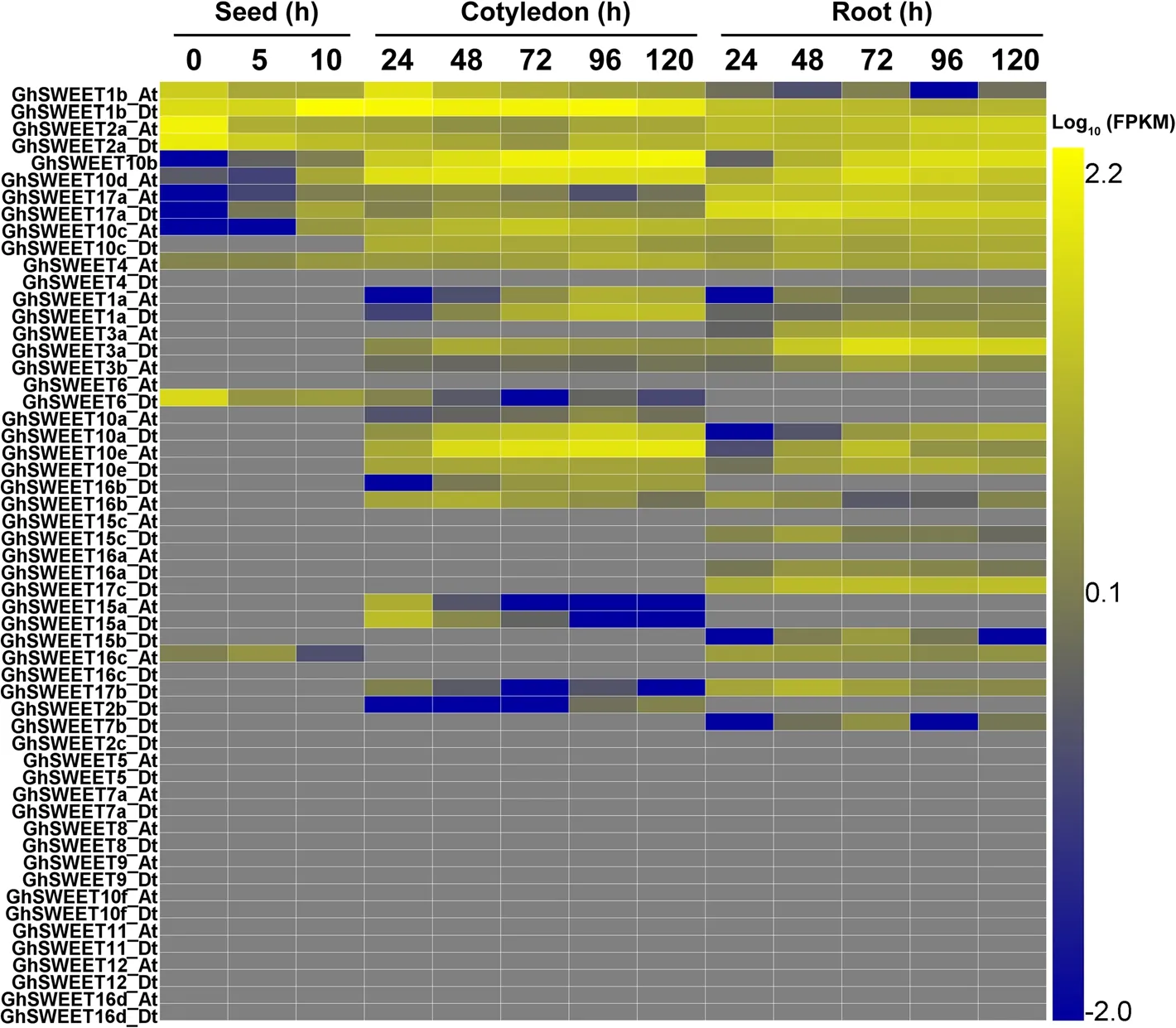
Fig.6 Expression patterns of SWEETs of G.hirsutum in seed germination,cotyledons and roots after germination
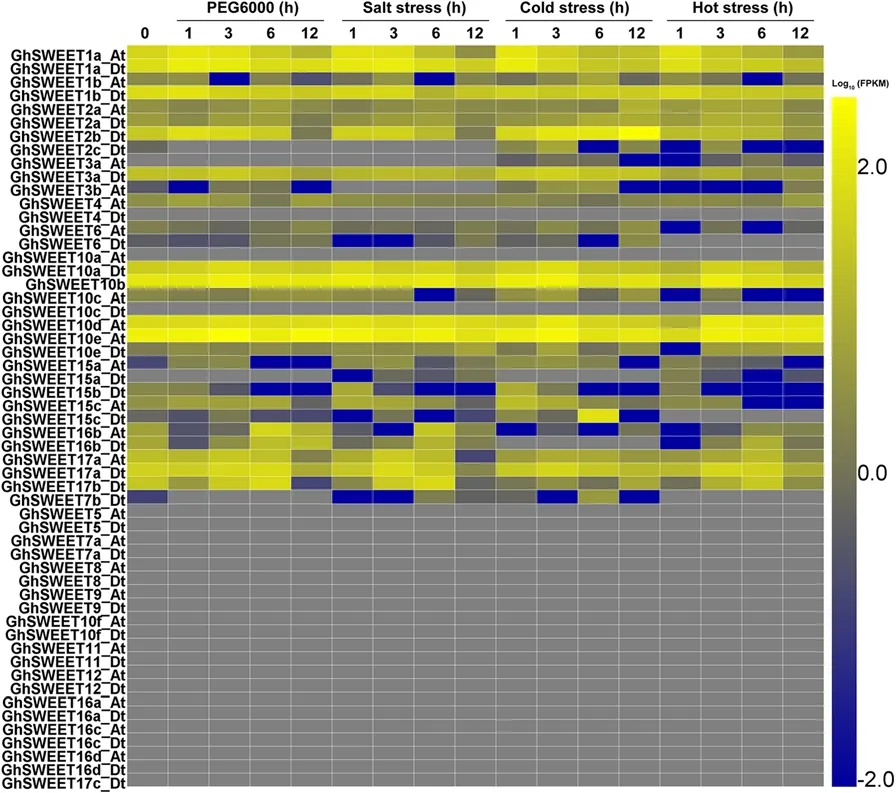
Fig.7 Expression patterns of SWEETs of G.hirsutum under different stresses
Cotton SWEETs have been highly conserved during the evolution
The OsSWEET2b protein is the only eukaryotic SWEET protein with resolved three-dimensional structure so far(Tao et al.2015).SWEET proteins generally contain seven transmembrane domains and two MtN3_slv domains(Chen et al.2010;Chen et al.2012;Talbot 2010;Baker et al.2012),the N-terminus and C-terminus are outside and inside the cytoplasm of the cell,respectively.Each MtN3_slv contains 3 TMs,that is,TM1-TM3-TM2 arranged in the form of a triple-helix-bundles(THB)(Chen et al.2010;Chen et al.2012;Talbot 2010;Baker et al.2012).The topology structure of SWEET proteins is clearly different from that of other sugar transporters,but their function is the same.In this study,most of SWEET proteins contain two MtN3_slv domains,though one or three domains are also founded in some genes,suggesting that the function is highly conservative in the evolutionary process.Most of the known sugar transporter proteins are located on the plasma membrane and are involved in the transport of sugars(Lalonde et al.2004).In this study,all members of the SWEET family identified from cotton were located on the plasma membrane,which is consistent with previous research of SWEETs localization(Chen et al.2012).However,recently,some study also showed that AtSWEET16/17 is located on the tonoplast involved in sugar transport.In addition,the length of SWEET protein varies significantly and the predicted isoelectric point is significantly different,suggesting that different SWEET proteins may play roles in different microenvironments.

Fig.8 Expression patterns of SWEETs under NaCl(a)and PEG 6000(b)treatment.The x-axis indicates different treatment times(h),and the y-axis indicates the relative expression levels of SWEETs.Error bars represent the standard deviation of three biological replicates
Expression and putative functions of SWEETs
Previous studies have shown that the SWEET genes regulates the transport,distribution and storage of carbohydrates in plants and is involved in many important physiological processes in plants including phloem loading,reproductive development,disease-resistance,stress response,host-pathogen interactions and so on.SWEET family gene expression patterns in upland cotton were analyzed and found that their expression patterns differed significantly.GhSWEET1a_At/Dt,GhSWEET2a_At/Dt,GhSWEET5_At/Dt,GhSWEET7a_At/Dt,GhSWEET9_At/Dt,GhSWEET15-c_At/Dt highly expressed in floral organs,indicating different members of the GhSWEETs family in cotton expressed in different parts ofthe flower and in different developmental stages.AtSWEET1/4/5/7/8,AtSWEET13/14/15 have a relatively high level of expression in floral organs of Arabidopsis(Feng et al.2015;Engel et al.2005;47 Wellmer et al.2006).OsSWEET1a/2a/3a/4/5/15 in rice also showed relatively high expression levels at different developmental stages of flowers and panicles(Feng et al.2015).This shows that SWEETs play a universal role in plant reproductive development.
GhSWEET7b_Dt,GhSWEET15c_At/Dt,GhSWEET10-c_At/Dt,GhSWEET15b_Dt,and GhSWEET10f_At/Dt highly expressed in seeds of different developmental stages,GhSWEET1b_At/Dthasnotonlyhigherexpression levels at different stages of seed formation but also during seed germination.The mutant of AtSWEET17 plants are dwarfed and have a low seed yield,suggesting that AtSWEET17 plays a role in the carbon distribution of plants(Chardon et al.2013).OsSWEET14 deletion mutation to the decrease of plant seed size and development delay.OsSWEET14 deletion homozygous mutant plants reproduction developed 30 days later than that of the heterozygous mutant(Braun et al.2014),suggesting that SWEETs are also involved in the development of plant seeds.SWEETs are reported to be involved in sugar transport during fiber elongation(Cox et al.2017).The high expression of GhSWEET1a_At/Dt,GhSWEET1-b_At/Dt,GhSWEET15c_At/Dt,GhSWEET10c_At/Dt,GhSWEET15b_Dt,and GhSWEET10f_At/Dt in fiber indicates that they may be involved in the fiber development of cotton and probably could be the candidate genes for further study ofcotton fiber development.
Under stress,plants can maintain the balance of cell osmotic potential by regulating the redistribution of soluble sugar in vivo,which helps the plants to maintain normal growth under stress(Slewinski 2011;Kuhn and Grof 2010;Eom et al.2015).Many SWEET genes in different plants are the key factors that regulate the redistribution of soluble sugar and respond to many abiotic stresses at the transcriptional level,indicating that they may be closely related to plant stress response(Yuan and Wang 2013;Klemens et al.2013;Seo et al.2011).The mutants have defects of AtSWEET11 and AtSWEET12 affects freezing tolerance in Arabidopsis(Hir et al.2015).In our study,some of the GhSWEETs show an up-and down-regulated expression under the stress of salts and PEG 6000.The GhWEET2a_At/Dt,GhWEET3a_Dt and GhWEET2b_Dt are Up-regulated undercold treatment,whileGhWEET10e_Dtand GhWEET4_At are Up-regulated under hot treatment.These results indicate differential expression suggested that the genes might have experienced functional divergence,and the study of SWEET function helps to artificially control the distribution of plant carbohydrates and has very significant potential value in improving crop yield,quality and cultivating new resistant varieties.
Conclusions
This study conducted a comprehensive analysis of SWEET gene family in the sequencing genomes of four cotton species for the first time.The SWEET family genes were classified into 4 groups in the phylogenetic tree.The SWEET genes are highly conserved among cotton and other plant species.A chromosomal location and gene duplication analysis revealed that segment repeat events promoted the expansion of the SWEETgene family in cotton.The duplicated genes may have undergone functional divergence in cotton because they showed different expression patterns in different tissues and organs.In addition,some members of the SWEET gene family may be involved in the regulation of stress response.This results promoted the understanding of the evolution of cotton SWEETgenes,were helpful in further studies on the function of cotton SWEET family genes in future.
Methods
Gene retrieval and genome-wide identification analysis
The genome sequence data of four cotton species,G.arboreum(BJI,version 2.0),G.raimondii,(JGI,version 2.1),G.hirsutum(NAU,version 1.1,BJI,version 1.0),and G.barbadense acc.XinHai-21(NAU,version 2.1)were retrieved from the CottonGen website(Yu et al.2014)and the CottonFGD website(Zhu et al.2017).
The rice(version 7.0),sorghum(version 3.1),cacao(version 1.1),poplar(version 3.0)and maize(version 1.1)genome sequence data were used from JGI(https://phytozome.jgi.doe.gov/pz/portal.html).Thecucumber(version 2.0)genome sequence data(http://www.icugi.org/)(Li et al.2011)were used.
To identify protential SWEET proteins in four cotton species,the published amino acid sequences of AtSWEETs(http://www.arabidopsis.org),OsSWEETs and CsSWEETs were used as query sequences.The obtained candidate genes and identified by performing a BLAST(E-value 1e-5)searches individually against the four cotton speciesgenome databases.Then,the MtN3_slv domain was searched from the obtained candidate genes by InterProScan(Jones et al.2014),and final the SWEETsequences were identified.The SWEETamino acid sequences from rice,cacao,poplar,tomato,sorghum,cucumber and maize were used and identified using the same method as employed for cotton species genome databases.Furthermore,the ExPASy tool(http://web.expasy.org/)was used to analyze the physicochemical parameters(i.e.,length,molecular weight,and isoelectric point)of SWEET proteins of cotton that were identified from the currently available genomic database.The subcellular localization of each gene was predicated by the CELLO v2.5 server(Yu et al.2004).The number of TM domains was predicted using the TMHMM Server v.2.0(http://www.cbs.dtu.dk/services/TMHMM).
Multiple sequence alignment and phylogenetic analysis
Full-length or domain amino acid sequences of SWEET proteins were multiple aligned using ClustalX 2.0.The phylogenetic tree was constructed using the NJ method of MEGA7 with the pairwise deletion option and Poisson correction model(Kumar et al.2016).For the reliability of interior branches,the bootstrap tests were performed with 1 000 replicates.To confirm the phylogenetic tree,constructed using the NJ method,the minimum-evolution method was also used.
Chromosome location and collinearity analysis
The physical chromosome locations of all SWEET genes were obtained from the genome sequence databases.The chromosomal location image was generated by Mapinspect 1.0 software.The predicted SWEET proteins were first aligned by ClustalW 2.0 at EMBL-EBI(http://www.ebi.ac.uk/Tools/msa/clustalw2/)prior to a gene duplication analysis.Gene duplication events were defined according to the following conditions:the alignment region covered more than 80%of the longer gene and the identity of the aligned regions was over 80%(Li et al.2017).The collinearity pairs of SWEET family were mapped using Circos software(Krzywinski et al.2009).
Gene structure analysis and conserved domain sequence prediction
Arabidopsis and the four cotton species(G.arboreum,G.raimondii,G.hirsutum,and G.barbadense)SWEETs sequences were aligned by ClustalX 2.0,respectively;and MEGA 7.0(Kumar et al.2016)was used to construct an NJ tree using the method and parameters as described above.The exon/intron organization of the individual SWEET genes from Arabidopsis and cotton were performed using the Gene Structure Display Server(GSDS,http://gsds1.cbi.pku.edu.cn/)(Hu et al.2014).Then,Inter-ProScan was used to analyze the SWEET protein conserved domain of the four cotton species(Jones et al.2014).
Transcriptome data analysis of SWEET gene expression from heat-map
The RNA-seq data was downloaded from the NCBI Sequence Read Archive(SRA:PRJNA248163,http://www.ncbi.nlm.nih.gov/sra/?term=PRJNA248163) and CottonFGD website(Yuan et al.2015;Zhu et al.2017).The fragments per kilobase million(FPKM)values denoting the expression levels of SWEET genes were isolated from a comprehensive profile of the TM-1 transcriptome data(Trapnell et al.2012).A heat-map analysis was performed using HemI 1.0 software(Deng et al.2014).
qRT-PCR
Cotton seeds of TM-1 were obtained from Shihezi University.The cotton(TM-1)seeds were germinated on a wet germinated disc for 3 days at 28°C,and then transferred to a liquid culture medium(Yang et al.2014).The seedlings were treated with 10%PEG 6000 and 300 mmol•L-1NaCl at the 34 leaf stage.The true leaves were collected at 0,1,3,6,and 12 h after the treatment and were immediately frozen in liquid nitrogen for RNA extraction.Total RNA was extracted from the seedlings.cDNA was synthesized by using an EASY-spin Plus Plant RNA Kit(Aidlab)with gDNA Eraser(Takara).The qRT-PCR reactions were conducted using a SYBR Green I Master mixture(Roche,Basel,Switzerland)according to the manufacturer’s protocol on a Light Cycler 480II system(Roche,Switzerland).The cotton histone(His)gene(GenBank accession no.AF024716)was used as a standard control.
Additional files
Additional file 1:Table S1.The members of SWEET gene family in G.raimondii.(XLS 26 kb)
Additional file 2:Table S2.The members of SWEET gene family in G.hirsutum.(XLS 33 kb)
Additional file 3:Table S3.The members of SWEET gene family in G.barbadense.(XLS 36 kb)
Additional file 4:Figure S1.Phylogenetic tree of SWEET genes indicating that SWEET genes could be divided into four clades.MEGA 7.0 was used for constructing the tree using the minimum-evolution method.The bootstrap values are shown near the nodes,and only those values greater than 50 are displayed.(TIF 2299 kb)
Additional file 5:Table S4.The paralogous pairs of SWEET genes in G.arboreum,G.raimondii,G.hirsutum,and G.barbadense.(XLS 17 kb)
Additional file 6:Figure S2.Phylogenetic relationships,gene structure and domain compositions of the GrSWEET genes.(a)Phylogenetic relationship between A.thaliana and G.raimondii.The phylogenetic tree was constructed using MEGA 7.0 with the jNJ method with 1 000 bootstrap replicates.The I clade,II clade,III clade,and IV clade is marked in cyan,purple,blue and pink,respectively.(b)Exon/intron structures of GrSWEETs.The introns and CDS are represented by orange boxes and black lines,respectively.(c)Protein domains.Each domain is represented in the colored box.(TIF 875 kb)
Additional file 7:Figure S3.Phylogenetic relationships,gene structure and domain compositions of the GhSWEET genes.(a)Phylogenetic relationship between A.thaliana and G.hirsutum.The phylogenetic tree was constructed using MEGA 7.0 with the NJ method with 1 000 bootstrap replicates.The I clade,II clade,III clade,and IV clade is marked in cyan,purple,blue and pink,respectively.(b)Exon/intron structures of GhSWEETs.The introns and CDS are represented by orange boxes and black lines,respectively.(c)Protein domains.Each domain is represented in the colored box.(TIF 1529 kb)
Additional file 8:Figure S4.Phylogenetic relationships,gene structure and domain compositions of the GbSWEET genes.(a)Phylogenetic relationship between A.thaliana and G.barbadense.The phylogenetic tree was constructed using MEGA 6.0 with the NJ method with 1 000 bootstrap replicates.The I clade,II clade,III clade,and IV clade is marked in cyan,purple,blue and pink,respectively.(b)Exon/intron structures of GbSWEETs.The introns and CDS are represented by orange boxes and black lines,respectively.(c)Protein domains.Each domain is represented in the colored box.(TIF 1078 kb)
Additional file 9:Table S5.Primers used for qRT-PCR in this study.(XLS 25 kb)
Abbreviations
BJI version 1.0:Beijing Genome Institute&Institute of Cotton Research of CAAS version 1.0;BLAST:Basic local alignment search tool;DPA:Days post anthesis;FPKM:Fragments per kilobase of transcript per million mapped fragments;FRET:Forster resonance energy transfer;G.arboreum:Gossypium arboreum;G.hirsutum:Gossypium hirsutum;G.raimondii:Gossypium raimondii;MSTs:Monosaccharide transporters;MW:Molecular weight;NAU version 1.1:Nangjing Agri.Univ.version 1.1;NJ:Neighbour joining;pI:Isoelectric point;qRT-PCR:Quantitative real-time polymerase chain reaction;SUT:Sucrose transporter;SWEET:Sugars will eventually be exported transporters
Funding
This work was supported by the The National Key Research and Development Program of China(2016YFD0101400,2017YFD0101600).
Availability of data and materials
The RNA-seq analyses for SWEETs are available in the Sequence Read Archive(SRA)(SRA:PRJNA248163,http://www.ncbi.nlm.nih.gov/sra/?term=PRJNA248163).All another data generated or analyzed during this study are included in this published article and its Additional files.
Authors’contributions
ZYS,ZLJ,YB conceived and designed the research.ZLJ,CW and LY performed the experiments.GY,LZY and WJY prepared the materials.ZLJ,LYJ and YL analyzed the data.ZLJ wrote the paper.ZYS and CW revised the manuscript.All authors read and approved the final manuscript.
Ethics approval and consent to participate
Not applicable.
Consent for publication
Not applicable.
Competing interests
The authors declare that they have no competing interests.
Publisher’s Note
Springer Nature remains neutral with regard to jurisdictional claims in published maps and institutional affiliations.
Author details
1State Key Laboratory of Cotton Biology,Institute of Cotton Research of Chinese Academy of Agricultural Sciences,Anyang 455000,China.2Anyang Institute of Technology,Anyang 455000,Henan,China.3University of Saskatchewan,Saskatoon S7N 5A5,SK,Canada.
Received:27 April 2018 Accepted:17 July 2018

杂志排行
Journal of Cotton Research的其它文章
- Identification and screening of nitrogenefficient cotton genotypes under low and normal nitrogen environments at the seedling stage
- Hypoxia tolerance studies for yield,fiber and physiological traits in cotton(Gossypium hirsutum L.)
- Map-based cloning of a recessive gene v1 for virescent leaf expression in cotton(Gossypium spp.)
- Comparative transcriptome study provides insights into acquisition of embryogenic ability in upland cotton during somatic embryogenesis
